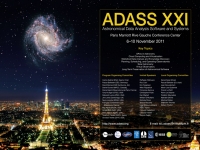Marc Labadens (CEA), Labadens, Chapon, Pomarède & Teyssier
Abstract
Computer simulations are important in current cosmological research. Those simulations run in parallel on thousands of processors, and produce huge amount of data. Adaptive mesh refinement is used to reduce the computing cost while keeping good numerical accuracy in regions of interest.
RAMSES is a cosmological code developed by the Commissariat à l'énergie atomique et aux énergies alternatives (English: Atomic Energy and Alternative Energies Commission) which uses Octree adaptive mesh refinement. Compared to grid based AMR, the Octree AMR has the advantage to fit very precisely the adaptive resolution of the grid to the local problem complexity.
However, this specific octree data type need some specific software to be visualized, as generic visualization tools works on Cartesian grid data type. This is why the PYMSES software has been also developed by our team. It relies on the python scripting language to ensure a modular and easy access to explore those specific data. It makes heavy use of the Numpy library C code, as well as specific Cython and C code to speed up the processing. In order to take advantage of the High Performance Computer which runs the RAMSES simulation, it also uses MPI and multiprocessing to run some parallel code.
We would like to present with more details our PYMSES software with some performance benchmarks. PYMSES has currently two memory friendly visualization technique which works directly on the AMR. The first one is a splatting technique, and the second one is a custom ray tracing technique. Both have their own advantages and drawbacks. We have also compared two parallel programming techniques with the python multiprocessing library versus the use of MPI run. The load balancing strategy has to be smartly defined in order to achieve a good speed up in our computation.
Results obtained with this software are illustrated in the context of a massive, 9000-processor parallel simulation of a Milky Way-like galaxyPoster in PDF format
Paper ID: P074
Poster Instructions
|

